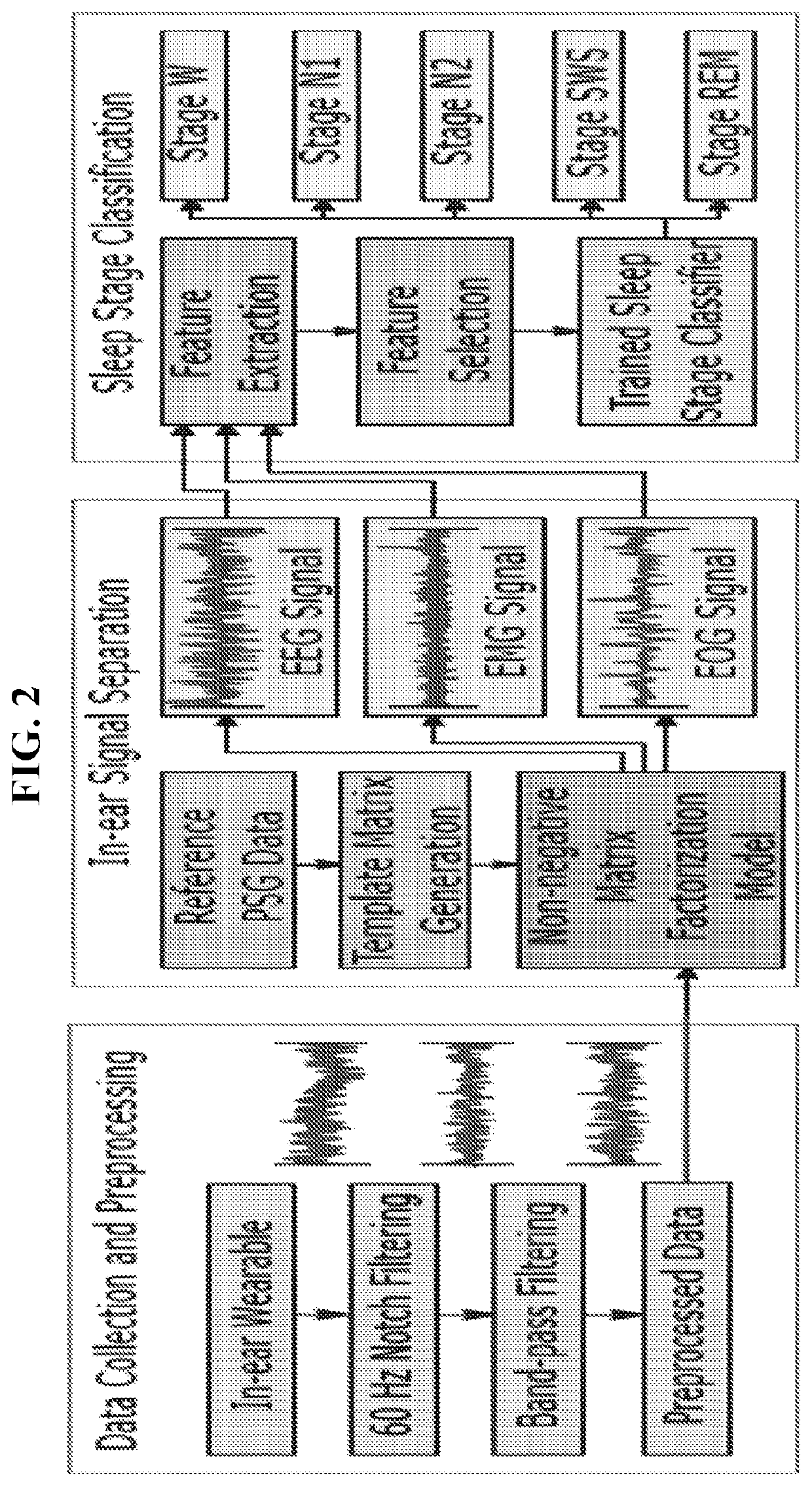In-ear sensing systems and methods for biological signal monitoring
a biological signal and in-ear sensing technology, applied in the field of in-ear sensing systems and methods for biological signal monitoring, can solve the problems of physical and mental serious harm, excessive number of young adults and adolescents are regularly sleep deprived, and insufficient sleep for peopl
- Summary
- Abstract
- Description
- Claims
- Application Information
AI Technical Summary
Benefits of technology
Problems solved by technology
Method used
Image
Examples
example 1
[0100]The present invention provides a sleep staging system that performs real-time sleep stage classification in a precise and convenient way. To counteract the limitations imposed by using PSG, an exemplary in-ear sensor was developed to monitor body's physiological signals that are important for sleep staging. Using this device can be as comfortable as wearing ear buds while listening to music. The exemplary system is composed of three primary components: a wearable biosignal recorder, a biosignal separation algorithm, and a sleep stage classification algorithm.
[0101]The exemplary wearable device allows the patient to have very few passive electrodes placed comfortably inside the ear for sensing the biosignals generated by brain activities, eye movements, and muscle contractions (EEG, EOG, and EMG signals, respectively). Because of the special in-ear location, the biosignal obtained by the exemplary in-ear device (in-ear signal) is considered as a mixture of the three separate si...
example 2
osignal Acquisition
[0113]In certain embodiments, a wearable device is unobtrusive, self-applicable (allowing the patient to apply the device herself), adjustable in fit to different size ears, convenient for long time use, and provides reliable signals. In other embodiments, the wearable devices of the invention suitably fit in the ear canal and can be worn easily and comfortably during a sleep to measure fundamental physiological signals from inside the ear for classifying the sleep stages. To meet these requirements, for example, the wearable devices can be made from a viscoelastic material (e.g., foam) with flexible wires to offer a comfortable long wearing during sleep. This design also helps eliminate the obstacles of dealing with the natural structure of the ear canal due to its small size and complex surface shape.
[0114]To capture the small amplitude biosignals from inside the ear, very sensitive electrodes made from soft and conductive materials (e.g., conductive fabric, sil...
example 3
d NMF-Based Signal Separation Technique
[0115]Due to the limited in-ear space, the signal sensed by the devices is inherently a single-channel mixture of multiple biosignals including EEG, EOG, EMG together with other unwanted noise. Specifically, the mixed signal captured by the sensors is a linear combination of multiple signals from a number of individual sources. A challenge in retrieving original individual signal stems from the fact that the number of channel that the sensor has (one channel) is less than the number of signal of interest (three signals).
[0116]To address the challenge, the present invention provides a supervised source separation technique that takes advantage of a non-negative matrix factorization (NMF) method to combine with the source-specific prior knowledge learn through a training process. Herein is described a process of leveraging different NMF techniques to learn source-specific spectral bases and to separate the mixing in-ear signal based on priory tra...
PUM
 Login to View More
Login to View More Abstract
Description
Claims
Application Information
 Login to View More
Login to View More - R&D
- Intellectual Property
- Life Sciences
- Materials
- Tech Scout
- Unparalleled Data Quality
- Higher Quality Content
- 60% Fewer Hallucinations
Browse by: Latest US Patents, China's latest patents, Technical Efficacy Thesaurus, Application Domain, Technology Topic, Popular Technical Reports.
© 2025 PatSnap. All rights reserved.Legal|Privacy policy|Modern Slavery Act Transparency Statement|Sitemap|About US| Contact US: help@patsnap.com



